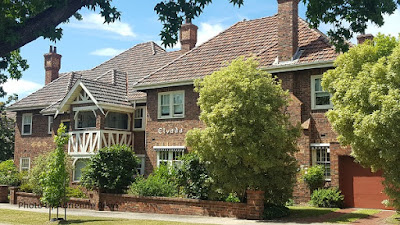When you stand in High Street, Armadale – constantly written about as
the epitome of contemporary style and one of Melbourne’s premier blue chip
areas – it’s hard to imagine it when it was first settled in the 1850s. Back
then, it comprised market gardens and nurseries with a few housing allotments
against a bush backdrop.
History notes that it wasn’t until the 1880s, that the boom years came
with the first trains into the area. Then, the land was sub-divided for
commercial and residential development and by 1890, High Street was populated
by bootmakers, tailors, dressmakers, milliners, wheelwrights, blacksmiths,
green grocers, upholsterers, iron mongers and the like – a far cry from today’s
stylish fashion boutiques and the plethora of Persian rug shops, antique
stores, nail and hair boutiques and bridal parlours that line the main Armadale
thoroughfare; and the millions of dollars’ worth of high-end cars that park
there.
I stayed in Armadale in December 2017-January 2018. I drove into the
cool, leafy, tree-lined residential streets, parked my car outside the villa
where I was staying and spent the next three weeks walking and photographing. I
fell in love with so much of the residential architecture – the huge old homes
that lined the streets – usually tucked away behind trees and high brick walls
and impenetrable gates – but just enough visible to pique my interest and set
me wondering about some other grand lifestyle.
I slipped over into neighbouring Toorak – long recognised as Melbourne’s
top suburb – and into adjoining Malvern, Hawthorne and Prahran; all of them
known for their expensive real estate. And in every street, I found a house
that, externally at least, set me to dreaming and to wondering what it might be
like inside.
I’ve always loved big houses and it was only a matter of time before I
found a way to explore further – albeit via a computer. Turns out it’s
relatively easy to get a glimpse inside many of these enormous, multi-million
dollar homes – you just look the address up on the Internet and if they’ve been
sold within the last decade, there’s usually a record of transactions, often
with real estate photographs supplied. Much less satisfying than an actual
house tour but enough to give you a hint of the interior of a $14-million home
you wouldn’t otherwise see inside. And yes, I did feel like a nosy pauper – but
only for a very short time.
Contrary to (my) expectations, Armadale is also a suburb of apartment
blocks – new and old. Its proximity to central city has always made it a
popular place to live and I liked the way apartment blocks of all ages sat
comfortable and appropriately, side-by-side with top-dollar houses –
integrated, appealing.
It’s a pleasant place to be – from a residential point of view; but the
neighbour’s don’t seem that neighbourly nor trusting, tucked away as they are
behind their impenetrable high walls and gates with security cameras and microphones
to see ‘who’s knocking.’ I guess it’s one way to keep unsolicited
‘doorknockers’ away from your actual door.
And I certainly did feel SECURE.
But there’s also something about the pristine, rigidly maintained
streets and sections that left me cold. For all the fabulous old architecture, for
all the high fashion, expensive, designers, bridal boutiques, antiques
(expensive) and posh restaurants, I found these wealthy suburbs lacking in
character - no graffiti to speak of, no
rough edges, very few book shops, no grunge, no mess....it's all a bit
sanitised for me and my photographic eye. I prefer places that are bit more
rough around the edges. Places more ordinary.
Places that encourage people to lives with gusto and colour.














